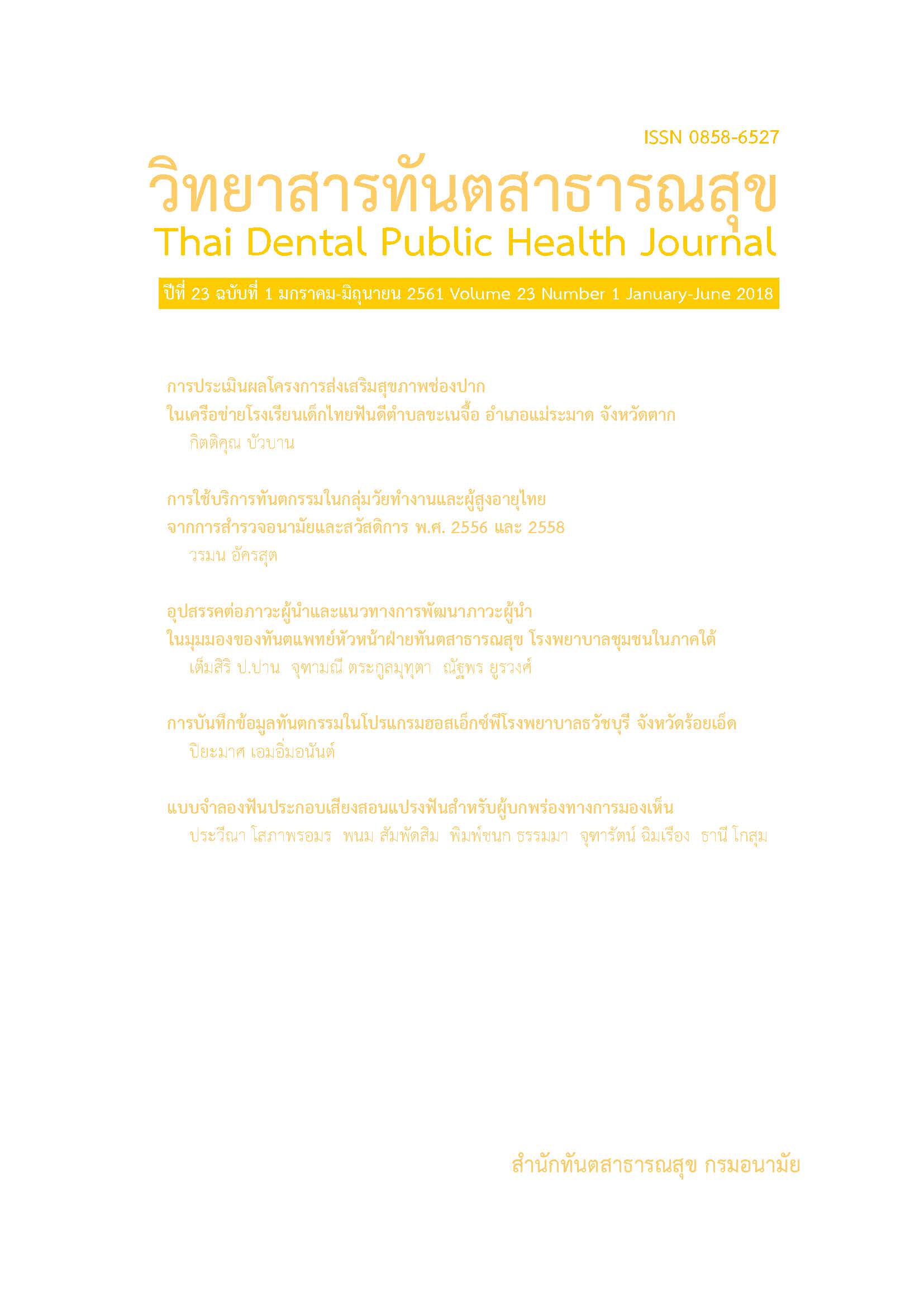Leadership barriers and the development in the perspective of dentists as heads of dental public health department in southern community hospitals
Main Article Content
Abstract
The objectives of this analytical study were to study the leadership barriers and leadership development among 134 heads of dental department in southern community hospitals. The data was collected during November 2016 to February 2017 using self-administered questionnaire which consisted of personal data and the open-ended questions about the leadership barriers and development approaches in their perspectives. The quantitative data was analyzed using descriptive statistics, chi-square and Fisher’s exact test which significant level was set at 0.05. The qualitative data was carried out by classifying, grouping and content analysis by 2 researchers. The response rate was 76.9%. The barrier aspects were their traits and insufficient skill, factors related to their colleague, organization aspect, and others 74.8, 17.5, 9.7 and 3.9 percent, respectively. The highest educational level was significantly related to the barrier of traits and skill whereas professional positions and the number of years as the department head were significantly related to the organization aspect. Leadership development approaches were suggested such as self-developments (34.0 percent), taking a leadership training course (30.1 percent), sharing experiences among department heads or successful leaders (14.6 percent), and enhancement of leadership development in under-graduate curriculum (9.7 percent). The highest educational level was significantly related to the suggestion of enhancing leadership in undergraduate curriculum. Whereas professional positions and the number of years as the department head were significantly related to other aspect suggestion.
Downloads
Article Details

This work is licensed under a Creative Commons Attribution-NonCommercial-NoDerivatives 4.0 International License.
References
2. Strategy and Planning Division. Details of 20-year strategic indicators of the Ministry of Public Health for fiscal year 2018. [online] 20 July 2018 [cited 2018 July 24]; Available from: URL: http://www.bps.moph.go.th/new_bps/ node /91
3. Thongpasaknow W, Rakjareon S. Role and responsibilities in oral public health and guideline in oral public health of primary health care sysytem. In Wongkongkathep S, Rakjareon S, Jitjamsai K, (eds). Oral public health guideline for oral health personel in primary health care system. Bangkok: Dental Health Bureau, Department of Health; 2009. p. 9-18. (in Thai)
4. Bureau of Dental Health. The 7th national oral health survey 2012 of Thailand. Bangkok: Department of Health; 2013. (in Thai)
5. Timofe MP, Ungureanu MI, Cetean A, Mocean F, Albu S. Leadership practices and percep-tions in oral healthcare: a scoping review. Oral Health Dent Manag 2017; 16(1):1-7.
6. Spano-Szekely L, Quinn Griffin MT, Clavelle J, Fitzpatrick JJ. Emotional Intelligence and Transformational Leadership in Nurse Mana-gers. J Nurs Adm 2016; 46(2):101-8.
7. Echevarria IM, Patterson BJ, Krouse A. Predic-tors of transformational leadership of nurse managers. J Nurs Manag 2017; 25(3):167-75.
8. Pillai R, Meindl JR. Context and charisma: A "meso" level examination of the relationship of organic structure, collectivism, and crisis to charismatic leadership. J Manag 1998; 24(5):643-71.
9. Pawar BS. Central conceptual issues in trans-formational leadership research. Leadership Org Dev J 2003; 24(7):397–406.
10. Wright BE, Pandey SK. Transformational leadership in the public sector: Does struc-ture matter?. J Public Adm Res 2010; 20(1): 75–89.
11. Walter F, Bruch H. Structural impacts on the occurrence and effectiveness of transforma-tional leadership: An empirical study at the organizational level of analysis. Leadersh Q 2010; 21(5): 765–82.
12. Nielsen K, Cleal B. Under which conditions do middle managers exhibit transformational leadership behaviors? An experience sam-pling method study on the predictors of transformational leadership behaviors. Leadersh Q 2011; 22(2):344–52.
13. Forest AE, Taichman RS, Inglehart MR. Dentists' leadership-related perceptions, values, experiences and behavior. J Am Dent Assoc 2013; 144(12):1397-405.
14. Brocklehurst P, Nomura M, Ozaki T, Ferguson J, Matsuda R. Cultural differences in clinical leadership: a qualitative study comparing the attitudes of general dental practitioners from Greater Manchester and Tokyo. Br Dent J 2013; 215(10):E19.
15. Morison S, McMullan C. Preparing for the future: challenges and opportunities for management and leadership skills. Br Dent J 2013; 214(1):1-5.
16. Brocklehurst P, Ferguson J, Taylor N, Tickle M. What is clinical leadership and why might it be important in dentistry?. Br Dent J 2013; 214(5):243–6.


